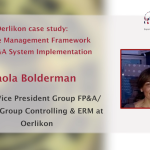Karina Williams, Business Unit CFO at Veolia Water Technologies and Solutions, shares her practical insights and...

Many FP&A professionals are no longer speculating about the future and imagining what could be possible one day.
With early adoption over, investing in tools with proven ROI and easy-to-follow steps may be a winning strategy for your organisation. However, we must step forward to bring powerful game-changing technologies, tools, and methodologies into our organisations.
Take the Lead
Being handed the leadership reins to roll out a Business Intelligence (BI) or planning tool may feel intimidating, but it doesn't have to be. The first step in getting comfortable with the project is to put a great plan together and lead others through it to completion. As a leader, you must identify the vision, resources, timeline, risks/opportunities, and gather cross-functional support to begin implementing the project.
It's better to spend more time preparing than fixing mistakes later. If you don't have much people leadership training, spend a weekend reading about Change Management best practices or take a course. Before leading change, it is wise to understand where your organisation is on the maturity scale.
Before the new analytical tool is touched, you should lead a small team to investigate and assess the quality of the organisation's data, identifying opportunities and risks along the way. Putting structure and resources into improving how data is captured and processed will pay dividends many times later in the project.
Ensuring you have a roadmap to check if the vision, skills, incentives, resources, and plans are determined, realistic, and actionable will add value and accelerate your Change Management journey.
Spend some time writing the plan down and communicating the message. Include the change's purpose in the communication to clarify why the change is happening and to prevent stakeholders from making assumptions that could get in the way of success. Communication planning will ensure that the messages are consistent and that stakeholders get the information on time.

Figure 1: Model for Managing Complex Change
Once you have completed the preparation work, you can advance to the first step in your analytical transformation.
Perform a Data Quality Assessment
For FP&A, there are typically some questions that must be understood before transformation. Data assessment is in the first place.
As many finance professionals know, data and process quality is paramount to successfully rolling out any analytical tool. Your team and project should develop and carry out a plan to assess the data's quality level and develop a plan to fix issues to improve data quality over time.
Self-train in Small Groups
Once high-quality data is available, it is time to identify and incorporate the right analytical tool(s) for your organisation and then begin training. You can find volunteers or else volunteer those with potential who can quickly learn and benefit from using a new analytical tool.
As a new tool is introduced, it is wise to communicate the vision and plan to be executed by defining who will do what and when. From there, trust your teams to determine the "how" and manage the training on their terms. Building a small group of internal experts will supercharge overall buy-in, as these folks will push others to see the fruits of their labour and time invested.
Even more, by creating a strong internal technical knowledge base, your organisation can reduce implementation costs and accelerate the speed of the tool's design, testing, and implementation. However, it can be nervous for some leaders.
Score Small but Meaningful, Visible Wins
The next step in your analytical transformation is to identify a small but meaningful use case where the new tool can be applied to solve a problem with a clear and measurable impact.
A small win reduces risks and further drives buy-in. Once people see and hear about the first implementation's success and understand how the tool benefits the organisation, other teams will ask to have their functional areas incorporated into the change. A great tip to remember is to look at the effects on both people and processes further down the line.
You'd be surprised by how much a small change can affect other things. Your communication plan, tasks, and next steps will be based on your analysis of the downstream effects, which will help you set priorities to lessen the impact.
Take the time to think about and write down who will be affected by the change and what processes will be changed. Make a complete list of the most influential people and the internal processes that will be affected. Have preliminary talks with the people who matter to find out if there are any unknown effects further down the line.
Conclusion
Now that you have ensured high-quality data, have proven the value of a new analytical tool, and have built a team of passionate internal experts, you are well-positioned to advance the project further.
After completing a successful pilot implementation, you can continue to progress on your Change Management plan and use the new tools to help everyone in the organisation collaborate better.
As a last word of advice, ensure you check in with your team and the people who matter most after making changes. This is a great chance to see what we've learned and where there are gaps. Ask for feedback not just on the change itself but also on how it is being made. The follow-up will help get people on board with the following small change and accelerate the project's momentum.
This article was first published on the SAP blog.
Subscribe to
FP&A Trends Digest

We will regularly update you on the latest trends and developments in FP&A. Take the opportunity to have articles written by finance thought leaders delivered directly to your inbox; watch compelling webinars; connect with like-minded professionals; and become a part of our global community.






